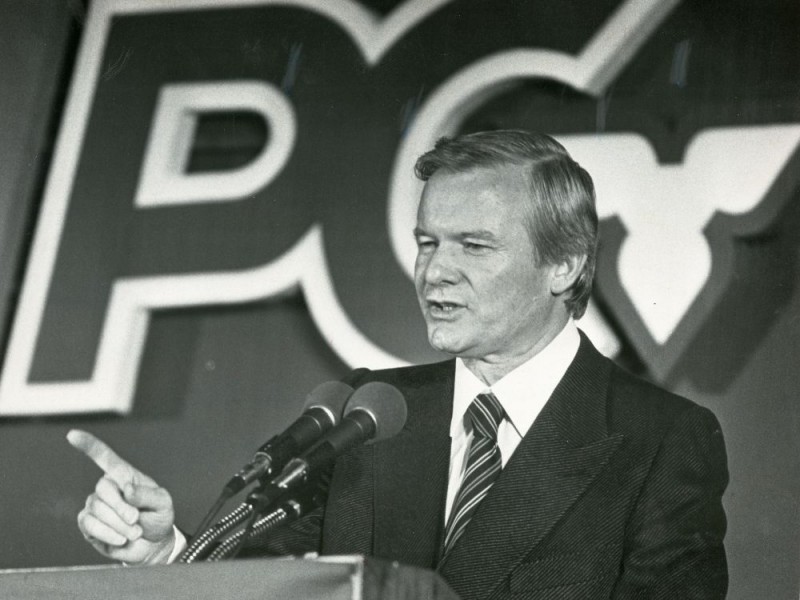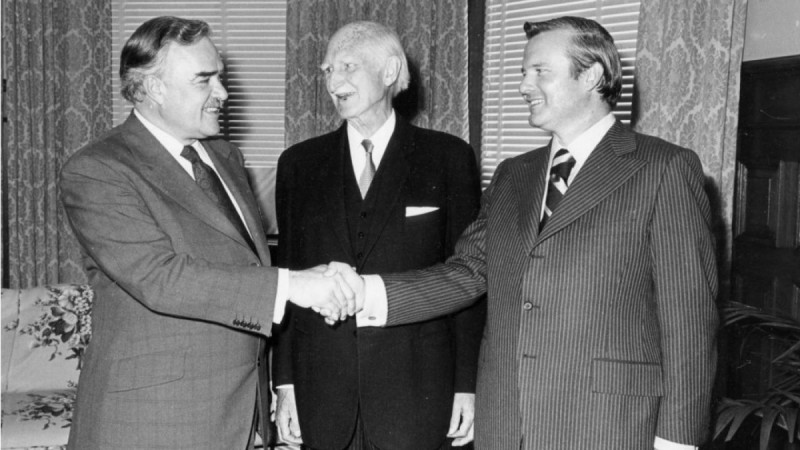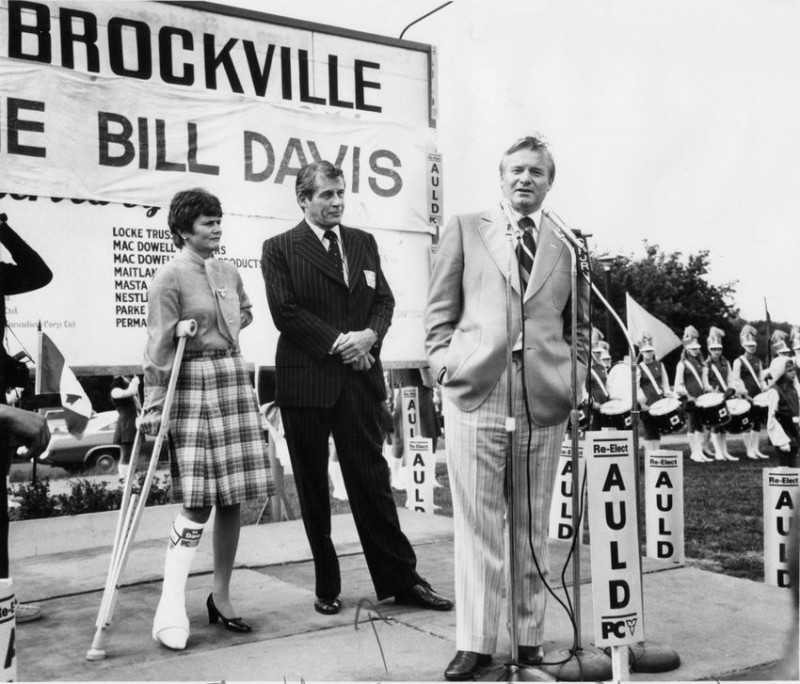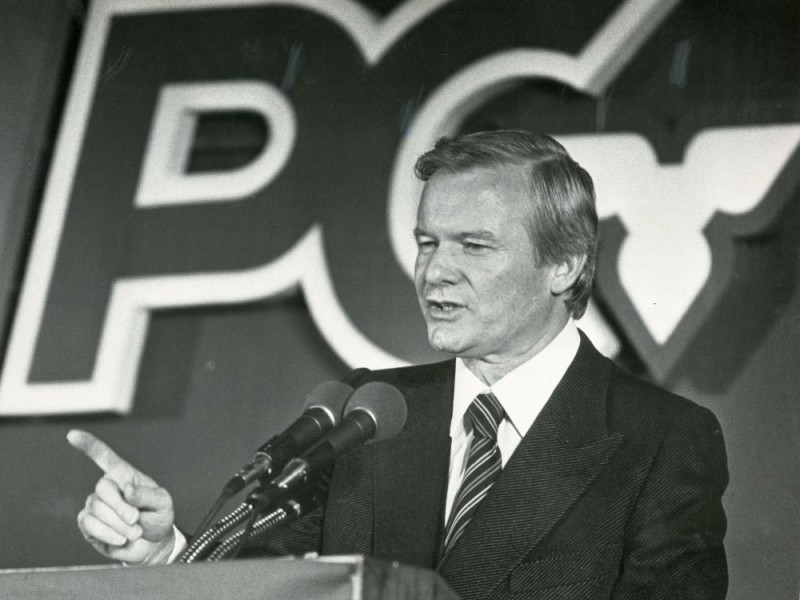Bill Davis’s anti-worker legacy

Ontario Progressive Conservative Premier Bill Davis replies to students from Carleton University at the Skyline Hotel, March 17, 1981. Photo by Russell Mant/Ottawa Citizen.
The death of former Ontario Premier Bill Davis, who led the province from 1971 until 1985, was announced on August 8. Gushing praise for Davis’s “contributions” were unanimous across the political establishment. But it is unfortunate to see some of the province’s current and former union leaders join in.
We got a taste of this in 2013, when then-Ontario Federation of Labour Vice President Julie Davis claimed Davis’s Labour Minister Bob Elgie “had a big heart, a big vision.”
Having more of a heart than recent and current Tory leaders is certainly a low bar to clear. But the real heart of the matter is that neither Davis nor Elgie nor their predecessors were qualitatively different from the Tories of today.
During the post-war boom, Davis oversaw the expansion of Ontario’s education system while minister under Premier John Robarts. At this time, capital demanded state assistance to develop the productivity of labour and compete. Davis’s “contributions” as premier, after the boom, included slashing health and education funding, attacking teachers and jailing union organizers. At this time, capital demanded cut backs. The continuity here is not kindness, goodwill or having “a big heart.”
The Ontario Tories are, at root, an anti-worker bloc, committed ideologically and organizationally to empowering capital over labour—even if some would prefer to use the carrot to the stick.
Any nostalgia for these right-wingers of the past must be soundly rejected.
What @fordnation has dragged the Tories into is a demolition of democracy. Even Bill Davis, one of the most respected PC Premiers in Ontario’s history denounces Ford’s use of the #notwithstanding clause. @OntarioPCParty must agree this is no way to govern the province #onpoli
— Smokey Thomas (@OPSEUSmokey) September 13, 2018
The party Davis joined
Born in 1929, Davis got involved in right-wing Ontario politics at age 15. He was a repeated convention delegate and a campaigner for MPP and Agriculture Minister Thomas Kennedy in his then rural riding of Peel.
Within a decade, the ruling Ontario Liberals, led by Mitch Hepburn were dwindling. Strikes were multiplying and the left-wing Cooperative Commonwealth Federation (CCF) was mushrooming.
On the right, the Conservative Party of Ontario, which had governed almost without interruption from 1905 to 1934, was rebranding as the Progressive Conservative Party. This rebranding is much mythologized by various liberals as the time when the Tories found a “social conscience.” This account, however, is contradicted by the officials themselves who stated plainly that their primary aim was to smash the broad left.
Progressive Conservative Party leader George Drew promised the wealthy his “Big Blue Machine” would defend the “great fellowship that was the British Empire” from “the evil geniuses of socialism” and their “school teacher” supporters.
Drew’s launched a broad “anti-socialist” campaign, aided by the Public Information Association and, allegedly, provincial police spies to undermine the CCF. The red-baiting campaign material famously depicted a CCF led by a “Jewish immigrant” working with “foreign operatives” to “destroy the Canadian way of life.” The party’s campaign was bankrolled by Inco, Massey-Harris, Royal Bank of Canada, Loblaws and other major companies, helping secure a 1943 minority and a 1945 majority.
Davis’s mentor, Kennedy, was in cabinet throughout much of this period and became “caretaker premier” after Drew’s exit to federal politics.
Kennedy handpicked Davis to replace him in Peel riding in 1959, seeing in him a potential future premier.
Davis in cabinet
Across Europe, following the Second World War, governments of various parties were pushed to enact welfare state policies—building health and education systems, developing public works projects, and the like. The Canadian equivalent occurred primarily under the Liberal Party federally and, strangely enough, under the Tories in Ontario.
At the federal level, as professor Donald Savoie noted, this involved reconfiguring much of the state machinery established during the war to serve profits afterwards. During the conflict, the federal government “got involved in virtually every sector of the economy and promoted a shift of power away from parliament to the cabinet.”
From 1939 until 1945, 60,000 orders in council and 60,000 treasury minutes were passed, roads were built and industrial capacity was massively subsidized. Finance Minister C.D Howe was dubbed the “Minister of Everything” empowered, as one critic phrased it, to build “a business man’s country.” After the war, the federal government proposed developing these tools into “a new arsenal of economic policy to achieve high employment and generally manage the economy.”
In Ontario, successive Progressive Conservative governments ruled the roost in Ontario for more than 40 years. During this time, they partnered with the federal government to construct much of what’s identified as Ontario’s welfare state with a roughly similar mandate.
This wasn’t because the 1943-85 Progressive Conservatives like Bill Davis had bigger hearts than today’s conservatives. Nor was it because they had a “passion for education,” healthcare, infrastructure or the like. The welfare state was supported and developed insofar as it served the needs of capitalism at the time. When the welfare of the population and needs of capital conflicted, capital always won.
The destruction of the Second World War and other factors in the post-war period allowed capitalism to overcome the overproduction of the 1920s and 1930s and set the stage for unprecedented economic expansion into the 1970s.
Capital flowed into Ontario at record pace and the result was an undoubted rise in incomes and economic activity. Canada’s labour productivity rose also from 82 percent of the US level in 1950 to 83 percent in 1973. From 1946-1957, the value of Canada’s total manufacturing output—much of it concentrated in southern Ontario—nearly doubled. This translated, through the 1950s, into annual GDP increases of six percent, accelerating to a “near-record pace of growth” in the early 1970s. Canada’s GDP per capita as a percentage of the US level also rose from 77.8 percent in 1950 to 82.9 percent in 1973.
As the OECD described it, Canada’s political class acted during this period as ‘salesmen’ whose primary duty was to recruit major manufacturing facilities.” While the province’s revenues ballooned, Ontario’s government, like others, turned towards Keynesian policies to support the industrial expansion.
Ontario’s successive post-war Tory governments intervened to subsidize and otherwise assist nearly every sector: energy, housing construction, manufacturing, transportation, forestry, steel, mining, technology and more. These governments also funded the construction and expansion of highways and expanded and centralized the province’s electricity output through the eventual development of Ontario Hydro and various nuclear power plants.
This period also saw Ontario’s government introduce, albeit tepidly, compulsory education to age 16 in 1954, the Ontario Medical Services Insurance Plan in 1966, and much of the existing education system.
Davis served as education minister starting in 1962, under Premier John Robarts, and during likely the largest expansion of the education system in the province’s history. This time saw the development of TVOntario (TVO), Ontario’s community college network, York, Brock, Trent, and Laurentian universities and the Ontario Institute for Studies in Education. This undoubtedly improved the living standards of children and youth in the province and it helped win the Tories support.
But that wasn’t the party’s primary function. Business needed technology, energy, land, roads and a labour force capable of serving increasingly productive industries. With an unprecedented expansion, funding these public works projects and social programs became doable.
Throughout the 1950s, 1960s, and 1970s the Tories remained Tories. The existence of social programs did not make the Ontario government a “neutral” actor when it intervened in the struggle of labour and capital.
Maclean’s wrote that the Ontario PC Party “consists of old fogies, young fogies and a lot of rich people willing to contribute millions to run the Big Blue Machine.”
And run it they did.
Enormous sums went to big business, especially to Tory donors. Meanwhile, special measures were maintained to repress workers throughout this period. Premier George Drew demanded Ottawa send the army into Windsor to crush the 1945 auto workers’ strike. Through 1946, his government deployed OPP officers against striking dockworkers and others.
Frost raised the minimum threshold for union certification and empowered municipalities to “opt out” of collective bargaining entirely.
Robarts imposed further restrictions on public sector workers’ ability to unionize and, in 1966, considered establishing a “labour court” allowing companies to sue unions for strikes, walkouts and boycotts. Towards the end of his premiership, Robarts further demonstrated his passion for repression when he offered “full confidence” to the federal government as it introduced the War Measures Act in October of 1970. As the military was deployed onto Québec streets, Robarts cheered “it’s war—total war.”
Former Ontario premier John Robarts (left) and Lieutenant-Governor Ross Macdonald (centre) with new premier Bill Davis in 1971. Photo by Dennis Robinson/Globe and Mail.
Davis’s early premiership: Budget cuts and more strikebreaking
When Davis became premier, in 1971, the post-war upswing was nearing its end.
In Canada and globally, post-war production was expanding faster than the market. Price shocks for key commodities, especially oil, were creating general inflation and eating into profits. Deficit financing was, for the most part, not helping. All of this combined meant multiple recessions Canada-wide from 1973-1985.
As Steven High notes in Industrial Sunset, the United States and Canada were facing growing international competition and domestic markets that weren’t keeping pace. Canadian plants, meanwhile, were often less productive than their US counterparts.
Subsidies did help some clear the costs of updating their equipment and machinery, but subsidies alone couldn’t generate a market. Consequently, regional development policy throughout this time increasingly spurred mergers and consolidation and, with that, job losses.
Keynesianism was helpful when the market was expanding. More productive industries took advantage of better infrastructure, industrial subsidies and an educated population with an expectation of steady returns. But by the 1970s, things were turning into their opposite.
With the new, expanded unionized workforce asserting itself and its demands on the government and employers, the old means of buying social peace were taken off the agenda.
Previously, Davis was praised by members of the Royal Canadian Yacht Club for making “procrastination a vital and important instrument in the running of a government.”
But the new period demanded cutbacks and attacks on working and living conditions. The working class would have to make do with less.
Throughout the 1970s, Davis decried the “competitive” advantage of US industry relative to Ontario’s and stated plainly on October 28, 1977: “Part of it is a question of wages; I’m not going to minimize that.”
Davis was also an early and explicit proponent of the federal government’s effort, under Prime Minister Pierre Trudeau, to cut wages and social programs—secured with comparable attacks on the right to organize and strike.
The first round of cuts
Soon after, Davis began cutting health and education funding.
Before 1970, education funding had increased by an average of 13.1 percent a year. By 1974, the increase in education spending had dropped to below eight percent, prompting larger class sizes and general deterioration.
In 1975, Davis further froze public sector salaries, discharged more than 1,000 employees and contracted out highway maintenance and snow plowing services. All told, from 1975 to 1980, approximately 7,000 public sector jobs were eliminated.
Davis appointed his successor, Frank Miller, to close hospital facilities, beds and health labs soon after. By 1980, southern Ontario’s hospitals had only 3.5 acute care beds per 1,000 people—the lowest in the country, before funding was cut further.
Davis’s finance minister further entertained advice from a Special Program Review for a sweeping $1.6 billion austerity program. The review suggested the government raise college tuition and cut college courses, lay off health-care staff and increase Ontario Hospital Insurance Plan (OHIP) premiums. The government also began looking to tighten social assistance eligibility, limit “welfare dependency” and kick off “welfare parents.” Among the review’s suggestions, as the Globe and Mail noted on November 21, 1975, was to have welfare recipients “sterilized or excluded from the welfare system.”
These cuts prompted a number of confrontations throughout the decade.
In 1972, strikes by Toronto municipal workers paved the way for Ontario’s Crown Employees Collective Bargaining Act. The act granted public sector workers the nominal right to collective bargaining—but this right was practically undone by the fine print. As Donald Carter notes, written into the act was “a complete prohibition against any form of strike action.” The government further designated issues related to classification, merit, performance evaluation and pensions the “exclusive domain of management.”
As teachers lacked the legal right to strike, they had previously resorted to “mass resignations” as a form of protest. Through the fall of 1973, teachers across nearly 17 different school boards all threatened mass resignations in response to government cuts. But on December 10, 1973, the Davis Tories tabled a bill to make these resignations illegal, initially with the support of the Liberals. When the Liberals rescinded their support, Davis complained of their “lack of intestinal fortitude” but ploughed ahead. The legislation was eventually defeated by an unlawful strike and mass rallies.
In 1974, during the Toronto Exhibition, TTC drivers struck against grueling 13-hour shifts and management’s attempt to casualize their work. Davis legislated them back to work, with votes from the Liberals.
With nothing settled, in 1978 the TTC workers were back on strike. Again, Davis introduced strikebreaking legislation to bring them to heel, acknowledging: “The issue was not going to be resolved through the normal collective bargaining process.”
In 1980, when 16,000 workers at 50 hospitals struck against low wages and gruelling workloads, the response was 35 firings, 3,500 suspensions and 5,600 disciplinary letters. When these workers were supported by the Canadian Union of Public Employees, Davis’ government responded by jailing union representatives. Confronted in Sudbury, Davis was unapologetic, promising that “as long as I’m premier, the law will be maintained.”
Bill Davis during the 1975 election campaign. Photo courtesy the Toronto Star.
Paring workers ‘to the bone’
Throughout the 1980s, Davis further attacked workers and planned deeper cuts.
Effective September 21, 1982, Davis’ Inflation Restraint Act extended all collective agreements by one year, suspended public sector workers’ right to strike and capped wage increases at five percent—against the highest inflation in 33 years. This regressive policy was intended, according to the subsequent budget, to spare the business owners “unwarranted growth in public expenditures.”
In 1983, Davis introduced the Public Sector Prices and Compensation Review Act which subjected all collective agreements to review by a “Restraint Board” mandated to consider employers’ “ability to pay in light of existing fiscal policy.”
In May 1984, the government amended the Labour Relations Act as “Bill 75” to allow for stiff penalties against anyone involved in a strike deemed unlawful, including rank and file members and community supporters.
All told, by 1985 Davis’s anti-union legislation was considered so extensive that the International Labour Organization ruled his government violated “fundamental” trade union freedoms.
By mid-decade, internal polling by the Tories warned “economic hard times” threatened their electoral viability and would likely benefit the ONDP most.
By the time Davis resigned, it was clear more cuts were coming. Media reports subsequently found the premier had promised the government’s bondholders in New York that his government would impose “strict restraint” on the public sector to maintain the province’s credit rating.
Journalist Rosemary Speirs notes in her book Out of the Blue that a leaked memo from Davis instructed ministers to “pare” transfers to fund schools and hospitals “to the bone” through 1985.
The 1985 election produced a minority PC government led by former Health Minister Frank Miller. Soon, however, Miller was ousted by a pact of the Ontario NDP and the Ontario Liberals, newly reformed by David Peterson. As premier, Peterson—previously on the right of the party —largely maintained expenditures from the Davis period, assisted by a speculative boom. But that boom wouldn’t last.
According to historians Bryan Evans and Carlo Fanelli: “The stock market crash of October 1987 presaged a changing economic environment; layoffs in Ontario’s industrial sector began to mount through 1988–89. Peterson opted for an early election before the political situation became unmanageable.”
On September 6, 1990, during the deepest economic crisis since the 1930s, the Ontario NDP secured a majority government while the Liberals recorded one of the worst defeats in Canadian electoral history. Pollster Allan Gregg told Maclean’s the outcome was a rejection of the political establishment. “Voters are saying to the politicians who held power in the 1980s, ‘A pox on all your houses’,” he wrote.
But while governments had changed, economic conditions had not.
“The bottom had fallen out of the Ontario economy,” Bob Rae wrote in his memoir. “Revenues were collapsing and impacts on people and their families were much greater than anyone had thought.”
While the provincial finance ministry estimated a $700 million deficit by March 1991, that soon rose to $3 billion—around 13.4 percent of GDP. Ultimately, the Canadian Centre for Policy Alternatives notes, the slump helped drive Ontario’s debt-to-GDP ratio to nearly double. And, facing this crisis, Rae and his government moved sharply to the right.
Davis’s post-resignation shadow
Even after stepping down as premier and even after the Tories were thrown out of office, Davis’s shadow loomed large over the province.
Patrick Monahan notes in his account of Bob Rae’s NDP government that, well into the 1990s, much of the state bureaucracy, especially within the Ministry of Labour, was unchanged from past governments.
Liberal journalist Thomas Walkom observed similarly: “In Ontario, four decades of Tory rule had so blurred the distinction between partisan politics and sound administration that the civil service of the cabinet office ended up doing both.”
Through the Rae period, this bureaucracy asserted itself with regular leaks to right-wing media and with “suggestions” for dealing with the province’s unions. On the whole, Monahan argued, “the civil servants’ agenda, more often than not, was identical to the business agenda.”
Towards the end of the Rae period, one anonymous civil servant told Walkom similarly: “The —welfare cutbacks and government downsizing—within six weeks of the government taking office.” When the Rae government faced a deep economic slump, the bureaucracy eagerly reviewed the Davis government’s 1970s and 1980s “wage control” programs—the same ones the NDP campaigned against—for cost-cutting models.
When the Rae government introduced its so-called “Social Contract,” tearing up collective agreements and forcing workers to take unpaid days off, Davis himself was not far.
The past premier personally phoned Rae to congratulate him: “You’ve done more to restructure that aspect of provincial spending than anybody, including me.” According to Rae, Davis—then sitting on “a number of corporate boards”—was eager to “mentor” the government through its successive austerity budgets.
Those budgets, which destroyed the ONDP’s support base, saw tuition fees balloon, hospital beds close and social assistance rates frozen.
Davis and the ‘Common Sense Revolution’
Following Davis’s resignation and Miller’s defeat, the Tories were split between an “Albany Club” wing and a more ideological right wing. The latter was represented, as journalist Christina Blizzard notes, by then-MPPs Mike Harris, Egon Zehnder International Inc. partner Tom Long, Tony Clement, David Lindsay and others. All of them would become key members of the Harris campaign and his inner circle. Almost without exception, each owed their political origins to Davis.
The Harris camp, subsequently, leaned on Tory insiders from the Davis period to set up over 50 private dinners with, as Blizzard describes them, “the movers and shakers and corporate elite of Bay Street” to secure campaign funds and to help draft his platform. In 1992 alone, John Ibbitson notes, Harris met with over 500 CEOs, corporate lawyers and business owners to drum up support.
While the PC Party came second in fundraising to the Liberals from 1987-89, the Harris PC Party out-fundraised both the Liberals and NDP from 1990-1995, despite third-party status. Prominent donors included George Weston, Barrick Gold, TD Bank, Merrill Lynch, Eaton’s Of Canada, RBC, Molson, Rogers, JJ Barnicke and others.
In power, Harris was more ideological about his attacks on the working class and the poor. He cut public spending by $1.9 billion—half of it from social assistance and the rest from hospitals, schools, transit and basic health and safety safeguards.
Those counter reforms persist. All told, in 2015, journalist Steve Paikin called Harris “the most transformational political leader in Ontario of our lifetime.” Today, Ontario has thousands fewer hospital beds than it did in 1990—a decline that began in the years 1990-95. Income support payments remain below 1993 levels
But, as journalist John Ibbitson notes, the “bland” Davis remained a party supporter throughout, even if he occasionally expressed discomfort with its many confrontations.
Davis endorsed Harris’s “Common Sense Manifesto,” and Harris used this to campaign. Davis also joined Harris at campaign rallies, at the opening of the legislature in 1995 and at the Empire Club in 1999. More importantly, TVO anchor Steve Paikin notes Davis was kept abreast of cabinet decisions often before some MPPs themselves. He continued to meet with subsequent Progressive Conservative Party leaders after Harris resigned and after the Tories were turfed from office.
No room for nostalgia
According to the Toronto Star, Davis deserves credit for having “ushered in Ontario’s modern era”—an era marked by underfunded hospitals, schools in disrepair, enormous restrictions on the rights of workers to organize and more.
Davis and past Tories did what they had to to remain in power and maintain the status quo as best they could. But that status quo always requires keeping the working class down.
When the economy was booming and the system could afford reforms, maintaining the status quo often meant reluctantly introducing social programs and providing occasional wage increases. In virtually every case, these programs were bound up with new anti-worker restrictions and plans to rein in spending. Following the end of the post-war upswing in the 1970s, these restrictions intensified and Davis inaugurated them as premier with anti-worker legislation and budget cuts. At all times, whether employing some Keynesian-style reforms or later implementing austerity, Davis was a faithful representative of the ruling class.
Mitchell Thompson is a writer, editor and occasional radio producer based in Toronto.

